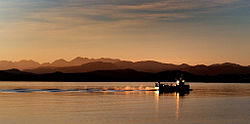Loch Ewe
| Loch Ewe | |
|---|---|

A Creel Boat on Loch Ewe at dawn
|
|
| Location | Northwest Highlands, Scotland |
| Coordinates | 57°50′13″N 5°36′44″W / 57.83694°N 5.61222°WCoordinates: 57°50′13″N 5°36′44″W / 57.83694°N 5.61222°W |
| Primary inflows | River Ewe |
| Primary outflows | The Minch |
| Basin countries | United Kingdom |
| Average depth | 15 m (49 ft) |
| Max. depth | 40 m (130 ft) |
| Islands | Isle of Ewe |
Loch Ewe (Scottish Gaelic: Loch Iùbh) is a sea loch in the region of Wester Ross in the Northwest Highlands of Scotland. The shores are inhabited by a traditionally Gàidhlig speaking people living in or sustained by crofting villages, the most notable of which, situated on the north-eastern shore, is the Aultbea settlement. The four-mile long River Ewe enters Loch Ewe from the following thirteen lochs of the surrounding basins (Ardlair, Slattadale and Ghruididh):
Due to the rugged and inaccessible terrain in which it is located, Loch Ewe has always been an assembly point for maritime trade. Around 1610 the area at the head of Loch Ewe, today known as Poolewe, was urbanised around an iron furnace utilising charcoal produced in the surrounding woodlands for fuel. English ironmasters found it more economic to ship the ore to Poolewe for smelting than to ship the processed charcoal to England to run furnaces there.
The crofting villages which were established in the 1840s, as a result of the local parish's estate being reformed from run-rig to fixed holdings properties, were always quite small. Bualnaliub, nine miles (fifteen kilometres) to the north of Poolewe, had eleven houses and fifty people at the 1841 census – twenty-three of whom were from the same (McIver) family. Mellon Charles, thence four miles (six and a half kilometres) to the west, had two hundred and sixteen people in forty-one houses – including seventeen houses headed by a McLennan. Ormiscaig, roughly halfway between them, had ten houses (four headed by McGregors) totalling forty-eight people. One hundred and forty years later, in 1981, the population was ten at Bualnaluib, twenty-four at Ormiscaig and one hundred and ten at Mellon Charles.
In 1911 a 70-foot lighthouse was built on the promontory between Gairloch and Poolewe.
Loch Ewe was used as an assembly point for the Arctic Convoys during World War II. Ships from the British, American and other ports gathered here before sailing to Murmansk from September 1942 following the disaster of Convoy PQ 17 in order to confuse German intelligence.
...
Wikipedia
